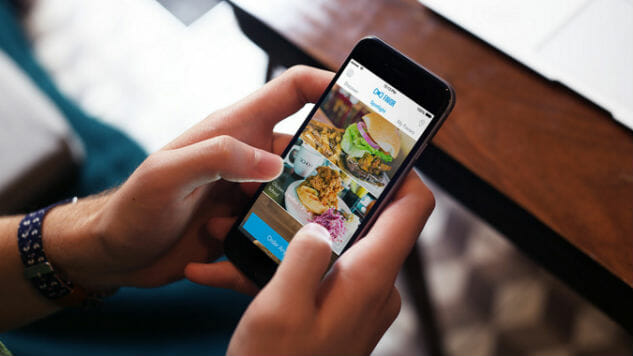
Today, there’s an app for getting and doing almost anything. Want food delivered to your door? There’s an app for that. Want to receive a professional massage in your living room? There’s an app for that. Need help managing your finances? There’s an app for that—in fact, probably multiple.
The market for social apps is huge—in fact, research projects that, by 2020, the app economy will double to $101 billion. When I think about the apps I use to catch a ride or have something delivered, I’ve realized that there isn’t one app I remain loyal to. I’ve tried six different food delivery apps in a given week, just to get a discount or free delivery.
It’s easy to move around between apps (especially ones based in the food delivery and rideshare industry) because the market is oversaturated, therefore, you don’t have to stick to just using one. It’s great for us—but what about the companies competing for our attention? In such an economically successful market, how do all these similar apps survive? Do you need to build the best brand, or just be the first person to get your app downloaded onto the phones in consumers’ hands?
A market supported by venture capital and hedge funds

There are two things an app needs to be successful: first things first, it needs to be a great idea and provide something people want; and secondly, it needs funding to survive.
Many apps are funded through venture capitalists and hedge funds-and then there’s the occasional successful Kickstarter-funded app. Since many apps offer an inexpensive service, there’s only so much they can make per customer. And if they want to keep prices low (especially when competitors emerge) they need to acquire some kind of financial support on the backend to do so. That’s why you’ll see so many companies raise millions in funding and then throw that money into marketing campaigns, referral programs, free rides, etc. etc.
In order to get this funding, an app has to be successful in the first regard, meaning, it needs to prove that its idea is good and that people do, in fact, want it. Apps usually have a beta test before going to market and when they launch in a market that’s when everyone (and especially investors) start watching.
The race to market

When Uber first came to market in 2011, it was the first of its kind. Previously, you had to hail a cab on the streets in New York, or call company to send a cab to your location. Or you had to wait in that extremely long line at the airport. Enter Uber and suddenly hitching a ride is as simple as clicking a button on your phone. Word of mouth about Uber spread like wildfire, likely because the company offered free rides to first time users, and a free ride incentive to referring your friends. Then, in June 2012, Lyft enters and challenges Uber with the same product under a different brand.
Similarly, the food and delivery industry has seen multiple apps pop up and just about everyone does the same exact thing. These apps are all racing one another to be in as many cities, and raise as much funding as possible, because they want to be the first to introduce themselves to a customer base. But, being first to market doesn’t always mean winning-and it doesn’t always make for the best product.
“You’re taking the logistics and compressing it into such a small timeframe, so it’s not something I think you should be rushing to the market,” says Jag Bath, CEO of Favor, a delivery service that takes a one-city-at-a-time approach.
Being first makes you the trailblazer and anyone who has ever had (or thought they have) an amazing idea for an app obviously wants to be the first to build it so they can say, “that was my idea.” It feels like being a copycat when you show up with the same product, so being first does create this sense of pride. In the beginning, your consumers will adore you, that is, until your competitor emerges with the “like this but better” approach. There are so many products that exist today that are basically better versions of something that showed up first, but we view them as the pioneers because we’ve forgotten who was first, or they succeeded in convincing us they were. Before Facebook, there was Myspace and Friendster. Before Spotify, there was Pandora and Napster.
Apps shouldn’t race to market because, by doing so, they’re essentially using their money to buy growth. Many companies raise millions in capital and throw their money into marketing ideas-referrals, free rides, free food, joining bonuses, etc., -and in the end, they get low quality customers. They get someone like me, who only wants to call an Uber or Lyft when I have a free ride and will take the bus the rest of the days. They get customers who will only use a delivery app if we can get some kind of discount off the total because that’s how it was introduced to us, and that’s how we always want it to be.
Uber was first to market in New York and San Francisco and basically held a three-year lead against Lyft in NYC. Despite being behind, Lyft has recently gained on Uber in New York. The rideshare companies have been aggressively lowering prices to compete for customers, and it appears Lyft has been successful in stealing Uber’s riders. Both companies have seen an increase in their shares of the for-hire vehicle market, hastily causing the taxicab industry to essentially lose their share of passengers. Even though it took a few years, Lyft is catching up with the first to market-so it doesn’t really matter that Uber showed up first, in the long run.
It pays off to be the latecomer

The biggest pro to being first to market is that you get the first chance to acquire customers, and if your product is amazing, getting there first might pay off. But, similar to what Bath said, rushing an app to market leaves much room for error.
Sara Schaer, co-founder and CEO of Kango, a mobile service that provides safe rides and childcare for kids (ages pre-school to high school) weighs in on the topic, noting that her company is currently the only licensed carrier that is insured to transport kids of any age.
“With a brand new type of service, a pro to being first includes having the chance to acquire customers before your competitors do, if you achieve product-market fit quickly and with sustainable economics,” Schaer explains. “Cons include having to spend more money to educate the customer about your type of product or service, having to figure out pricing without competitor benchmarks, and having to meet regulatory requirements that are not necessarily clearly defined.”
Kango’s Rides and Care service came out of beta in the San Francisco Bay Area several months after Shuddle, which was the first to enter the rides for kids market. But, Shuddle ceased operating in mid April of this year.
“When it comes to ridesharing for kids, where trust, safety, and reliability of service are paramount, creating a product with those qualities and a solid business model, is a greater success factor than simply being the very first to market,” says Schaer.
Though being a trailblazer can have its perks, in the business world, you don’t always find success when you’re the first brave soul to explore uncharted territory. Because if you fail and your competitor brings forward the same product with improvements, your customers are going to switch sides. That might seem unfair, but in the end, this is business and it can pay off to be the latecomer.